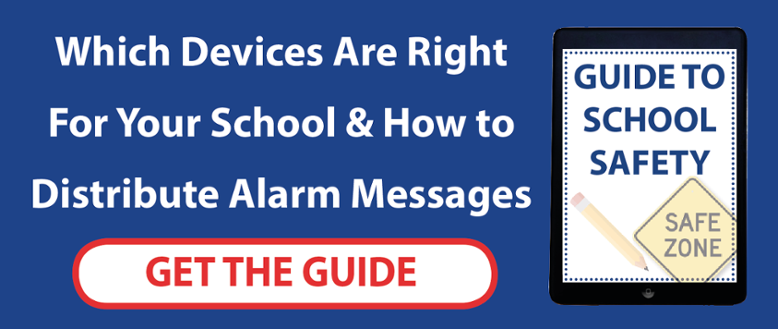
With classroom violence on the rise, and over a quarter of teachers reporting being attacked each week whilst at work, schools are increasingly looking for ways to tackle the most serious incidents. Purpose-made lockdown systems are one form of defence. Educational institutions in the US have for a long time used the so-called 'lockdown' technique to tackle threats to students from either problem pupils or outsiders. Lockdowns are a way to completely shut down the school in the event of a threat of imminent physical violence to staff or students.
The lockdown consists of instructing teachers to gather their students together and then seal the entrances to their classrooms, thereby preventing a threatening individual from causing harm. It also means that many doors throughout the school will be closed, containing the intruder until emergency services are able to arrive and deal with them. Lockdowns can be used in a wide variety of situations where there is a risk of violence throughout the school.
There are several broad categories into which incidents that may require a lockdown can be placed. The first of these is external threats, whereby someone may come into the school from outside, looking to cause harm. These people often include angry parents seeking to confront a teacher or gain access to a child they are legally barred from seeing, others are more regular intruders such as thieves or vandals who may pose a threat to people who get in their way.
Internal threats tend to come from amongst the students themselves, with most lockdown incidents of this kind stemming from escalations of classroom violence. Serious violent incidents can also necessitate a lockdown, with school stabbings or gang violence being the worst case scenarios. It may also be prudent to lock down the school in the event of a medical emergency, so that a student can be evacuated from the premises and so emergency services can easily move around the site.
Whilst the technique itself is an effective way to prevent dangerous situations from escalating, it is often the implementation by staff that causes the lockdown to either be delayed or be conducted piecemeal, undermining the point of exercise. A quick response is key when initiating a lockdown, meaning that using word of mouth or phone calls to instruct staff to initiate a lockdown is too slow a method. Instead, we can automate the process to save valuable minutes.
By upgrading to a critical alarm management system, staff members can use a purpose-built app installed on their smart devices to raise alarms on a centralised computer system. Once logged, the alarm is sent out via the app to other staff members in seconds, far faster than if a human was required to carry out the same task. Depending on the exact nature of the emergency, notifications may be sent to specific staff who have key responsibilities (i.e. closing certain entrances and clearing students out of different areas).
With permission of senior staff, a lockdown notice can be authorised in moments. The system can be configured to send out a pre-arranged notification so that all teachers can put the school lockdown procedure into effect immediately. This has the added benefit of not alerting the aggressor by sounding an audible alarm bell, which may otherwise cause them to become more dangerous. Teachers can also update the alarm system with further information as events progress, allowing everyone to easily keep abreast of what is going on.
One major advantage of the critical alarm management system is the ease with which teachers can use and install it, making it simple to log issues on the system and then update them with detail as the situation progresses. However, the system also logs all interactions, meaning that senior staff can take the opportunity after the lockdown is over and the crisis has been resolved to analyse what happened. This is a powerful tool when it comes to making the school lockdown system as effective as can be, as shortcomings in the school's plan can be readily identified and corrected after the fact. Thus, procedures can easily be optimised to offer the highest level of protection, without needing staff to go through arduous briefings after each incident and instead concentrate on getting back to work.
Situations that require a lockdown to be put into effect can change rapidly and plans need to be updated as the scenario progresses. This is especially true when teachers are coming into contact with the dangerous individual if they gain access to classrooms. In such situations, the staff member will need to summon help in order to protect both themselves and their pupils, though this runs the risk of agitating the intruder if the regular app is used. Fortunately, smaller devices are available that can send out an instant request for help at the push of a button.
These mobile personal emergency response devices (also called MPERS) can be kept on the teacher's person as a wearable item, or they can be installed in a hidden, fixed position inside the classroom. This way, teaches can simply hit a button discreetly and know that their colleagues have been alerted, giving them the opportunity to try and calm their opponent down. Lockdown systems can be made more effective by these rapid alerts and staff can be directed accordingly, keeping the threat contained.
ANT makes a range of hardware and software packages for schools, which can be specifically set up to issue lockdown orders when instructed. The high degree of modularity of the offerings from ANT means that an installation can be tailored to meet virtually any need or budget. This also provides managers with a large amount of customisation, so that they can massively enhance their school's safety procedures whilst requiring minimal time to be spent retraining their staff. This ability to easily conform to guidelines and plans that are already in place also means that packages are easy to put in place, acting as a bolt-on upgrade to the school's systems.





